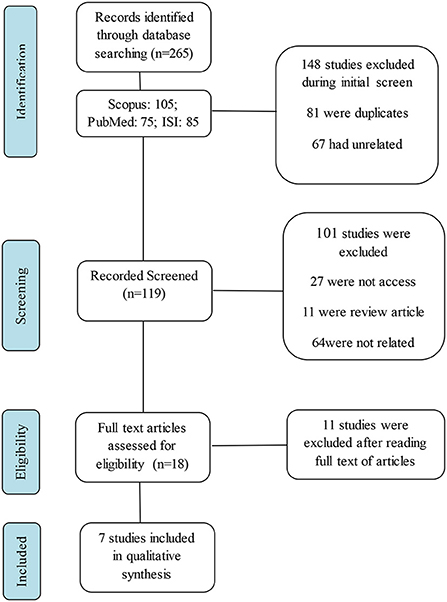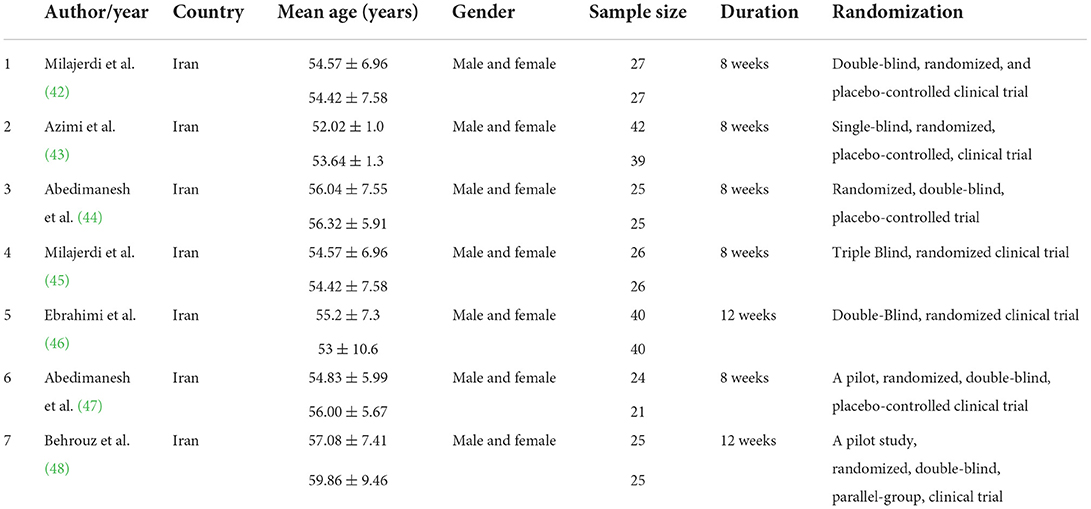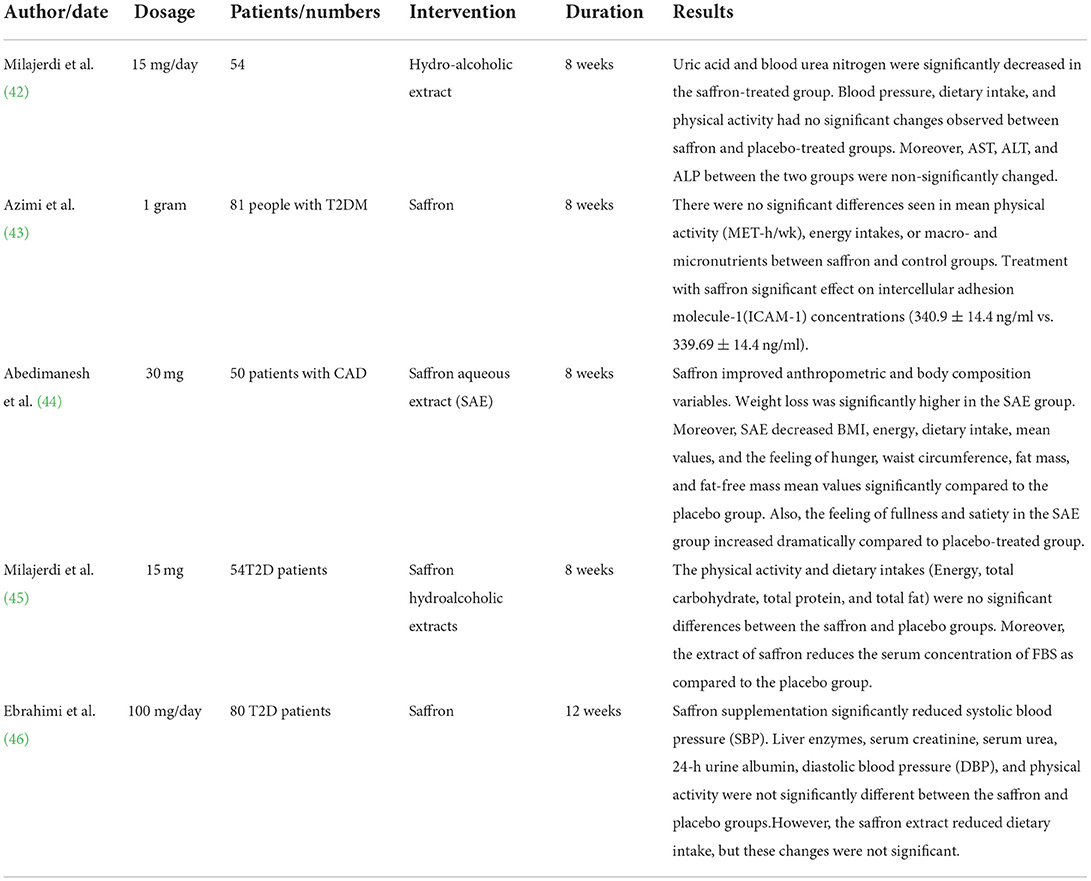- 1Esfarayen Faculty of Medical Sciences, Esfarayen, Iran
- 2Cardiovascular Diseases Research Center, Birjand University of Medical Sciences, Birjand, Iran
Cardiovascular disease (CVD) is one of the most common causes of mortality around the world. The aim of this study is to summarize and conclude the clinical evidence regarding the use of Crocus sativus (C. sativus) and its ingredients on cardiovascular risk factors. A systematic search was conducted with PubMed, Web of Science (ISI), and Scopus in the English language from 2015 until September 2021. A fixed-effect or random-effects model were applied to pool standard mean difference (SMD) and its 95 % confidence intervals (CI). Randomized controlled studies that assessed the clinical effects of C. sativus and its ingredients on dietary intake (Energy, Carbohydrate, Protein, and total Fat) in human subjects were included. Seven studies comprising 421 participants were included in the meta-analysis. Pooling of results showed significant effect of saffron on total fat (−0.14; 95% CI: −0.49 to 0.20; I2 = 57.3%) and significant effect of crocin on Energy (0.94; 95% CI: −0.77 to 2.65; I2 = 95.9%), Carbohydrate (0.44; 95% CI: −0.74 to 1.62; I2 = 92.6%), and Protein (−0.04; 95% CI: −0.26 to 0.34; I2 = 0.0%). Present meta-analysis suggests that treatment with crocins is more effective than saffron in energy, carbohydrate, and protein, while saffron is more effective than crocins in fat. However, further studies are needed to confirm these findings.
Introduction
Cardiovascular disease (CVD) is the most important cause of death in Iran, and indeed most countries scross the world (1). The prevalence of CVD has increased significantly worldwide due to its close association with lifestyle factors such as inactivity, smoking, and poor eating habits (1–3). It is also developing in Iran (4, 5), where in particular abdominal obesity can increase metabolic heart risks through blood pressure, type 2 diabetes, hyperlipidemia, and insulin resistance (6, 7). Control of CVD risk factors reduces mortality from ischemic or coronary heart disease (CHD) because high cholesterol, high blood pressure, smoking, and physical inactivity (of at least 75%) cause new cases of CHD. These findings are encouraging individuals to lead a healthy lifestyle. In other words, healthy eating habits and tobacco, including smoking, have been characterized by the WHO as one of the biggest public health threats (8). In addition, CVD reduces patient life expectancy as well as induces a financial burden on patients and governments (9). Therefore, it is essential for any health care system to adopt appropriate strategies for the management and treatment of CVD and related diseases (10).
Crocus sativus L (C. sativus), known as saffron, is a small perennial herb belonging to the family Iridacea. This plant is cultivated in many countries with mild and dry climates, especially Iran, Afghanistan, Turkey, Greece, and Spain (11, 12). This herb is native to Iran (13) was used traditionally as a medicine beginning more than 3,600 years ago (14).
According to chemical analysis, there are more than 150 components in C. sativus stigma, including crocins and crocetin (carotenoids). Crocins are members of a family of molecules which are formed from crocetin which is responsible for the yellow color of saffron (15). Picrocrocin (apocarotenoid) which gives saffron its flavor, and safranal (monoterpene Aldehyde) which is responsible for the aroma, were also identified (16–18).
Various medicinal properties of saffron and its compounds have been extensively studied, including anti-cancer (19, 20), anti-depressant, anti-Parkinson's, anti-ischemic (such as brain, kidney (21), muscle, and heart ischemia), anti-hypertensive, anti-genotoxic and antidote (eg against snake venom, diazinon, acrylamide, or acrolein), antitussive, hypolipidemic, anti-inflammatory (18, 22, 23), anti-Alzheimer's (24), and antioxidant (25, 26). Also, the protective effects of saffron and its components on the respiratory system have been reported (12, 27).
In traditional medicine in different countries, saffron is used for various purposes such as analgesic and anti-inflammatory (earache, toothache, swelling, otitis, anal pain, gout, cancer pain, gingivitis), cardiovascular system, eye disease (painful eye, day blindness, corneal disease and cataract, eye infections, and poor vision), gastrointestinal system (stomachic, anorexia, treatment of hemorrhoid, jaundice, anti-flatulence, and enlargement of liver), genitourinary system (abortion, treatment of amenorrhea, use in the puerperium period, terminate pregnancy, painful urination, diuretics, and kidney stones), infectious disease (antibacterial, antiseptic, antifungal, measles, smallpox, and scarlet fever), respiratory system (Asthma, bronchitis, expectorant, pertussis, and antitussive), skin Disease (treatment of psoriasis, eczema, and acne) (28), and other cases (Immunostimulant and tissue coloration) (18), relieving symptoms of PMS (29), and central nervous system (anti-hysterical, CNS stimulant, hypnotic, mental disease, sedative and anticonvulsant (30, 31).
As mentioned earlier, CVD is the leading cause of death worldwide (1). Platelet activation and accumulation play a key role in homeostasis and thrombosis. Herbal remedies have long been used to treat a variety of ailments, including cardiovascular disease (32). Herbs can play an important role in improving the progression of cardiovascular disease, especially platelet function, as well as some coagulation parameters. Herbal remedies such as feverfew, garlic, ginger, ginseng, and willow bark have been found to be effective in cardiovascular diseases (33). Saffron has been traditionally used to improve cardiovascular functions, increase heart health, and in treatment of palpitation (34). In the current study, we conducted a meta-analysis to determine the effects of saffron and its derivatives on cardiovascular disease. The findings of this study can help us find new herbal remedies for cardiovascular disorders. The efficacy of saffron and its main carotenoid, crocin on lipid profile, appetite level, dietary intakes, anthropometric indices, and body composition in patients with coronary artery disease were evaluated.
Methods
Search strategy
The present study was performed according to the Preferred Reporting Items for Systematic reviews and Meta-Analyses (PRISMA), (35, 36).
We searched the published studies in databases such as; PubMed, Web of Science (ISI), and Scopus in the English language until September 2021.
TITLE-ABS-KEY “crocin” OR TITLE-ABS-KEY “crocetin” OR TITLE-ABS-KEY “saffron” OR TITLE-ABS-KEY “Crocus sativus linn” AND TITLE-ABS-KEY “hypertension” OR TITLE-ABS-KEY “ blood pressure” in the Scopus:105
“crocin” [Title/Abstract] OR “crocetin” [Title/Abstract] OR “saffron” [Title/Abstract] OR “Crocus sativus linn” [Title/Abstract] AND “hypertension” [MeSH Terms] OR “blood pressure” [Title/Abstract] in PubMed: 75
TS= “crocin” OR “crocetin” OR “saffron” OR “Crocus sativus linn” AND TS= “hypertension” OR “blood pressure” in ISI=85.
Inclusion criteria
All clinical studies that investigated the effect of crocin, crocetin (or saffron, Crocus sativus linn) on coronary artery disease (CAD) patients were included in the study.
Exclusion criteria
Review articles, editorials, duplicates, animal studies, and clinical studies about the effect of crocin (or saffron, Crocus sativus linn) on coronary artery disease (CAD) patients without a control group were excluded from the study.
Statistical analysis
The heterogeneity between studies in a meta-analysis will exist. This heterogeneity may be of clinical, methodological, or statistical origin. Quantifying statistical heterogeneity through I2-statistics is only helpful when the amount of clinical heterogeneity is unknown and I2 is high (37). Given statistical heterogeneity between studies, fixed-effect, or random-effects models were done, and calculate the standardized mean differences (SMD) and its 95% confidence intervals (CI), (38). To assess the statistical heterogeneity, I2 > 50% (high) and P-value <0.05 (significant) were used (39).
The SMD is used when reporting effectiveness studies in terms of continuous measurement. The SMD is known as Cohen's d (40). The SMD is computed with this formula (41):
SMD = (new treatment improvement – comparator (placebo) improvement)/pooled standard deviation (41). A P-value <0.05 is considered statistically significant.
Results
Literature search
Initially, 265 articles were extracted. All unrelated studies including; duplicates, animal, and review studies as well as clinical studies without a control group were removed and seven articles were considered for further evaluation after reviewing the titles and abstracts of the extracted articles (12, 41, −47), the process of study selection is shown in Figure 1.
Trial characteristics
Demographic characteristics of the seven included trials containing 412 subjects that were published between 2016 and 2021 are shown in Table 1. The mean age of participants ranged between 52.02 to 56.32 years old. The treatment period was 8 or 12 weeks (13, 42–48). The Nutritionist IV for Windows software was used to analyze energy and macronutrient compositions (The Hearst Corporation, San Bruno, California.) in the trials (44).
Meta-analysis
The association between saffron and energy
Combining the results of 5 analytic studies using a fix effect model (I2 = 42.2%, Q = 6.92, P = 0.140), showed the pooled SMD for energy were 0.09 fold lower in saffron group (95% confidence interval:-0.310, 0.133) (Figure 2A). Based on the Egger regression plot (t =-1.05, p = 0.373) no publication bias existed.
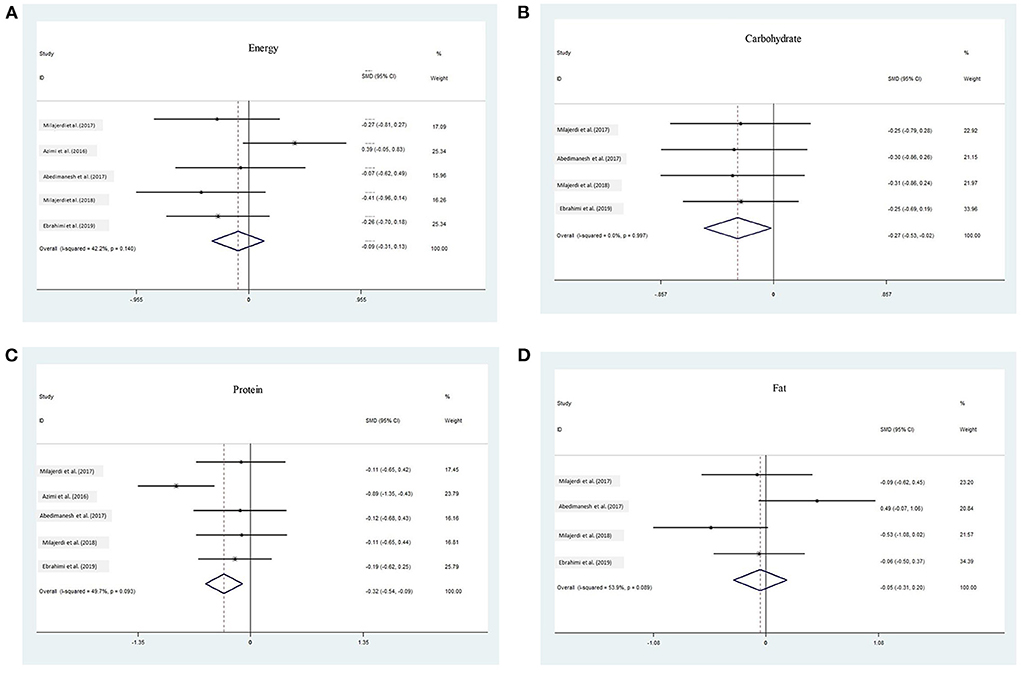
Figure 2. The association between saffron and (A) Energy, (B) carbohydrate, (C) protein, and (D) fat.
The association between saffron and carbohydrate
Fix effect meta-analysis of four studies (I2 = 0.0%, Q = 0.05, P = 0.997) showed that carbohydrate were 0.27 fold lower in saffron than control group (pooled SMD: −0.27; 95% CI:−0.53,-0.02) (Figure 2B). Based on the egger test (t =-1.56, p = 0.259), no publication bias existed.
The association between saffron and protein
Combining the results of five analytic studies using a fix effect model (I2 = 49.7%, Q= 7.95, P = 0.093), showed the pooled SMD for energy were 0.32 fold lower in saffron group than control group (95% CI: −0.54, −0.09) (Figure 2C). Based on the Egger regression plot (t= 1.07, p = 0.364) no publication bias existed.
The association between saffron and total fat
Fix effect meta-analysis of four studies (I2 = 53.9%, Q = 6.51, P = 0.09) showed that fat were 0.06 fold lower in saffron group (95% CI: −0.31, 0.20) (Figure 2D). The Egger test showed (t = 0.13, p = 0.908), no publication bias existed (Table 2).
The association between saffron ingredients on energy
Combining the results of three analytic studies using a fix effect model (I2 = 95.4%, Q = 43.83, P = 0.000), showed the pooled SMD for energy was increased 0.459 fold in the crocin group over the control group (95% CI: 0.1, 0.819) (Figure 3A). Based on the Egger regression plot (t = 44.32, p = 0.02).
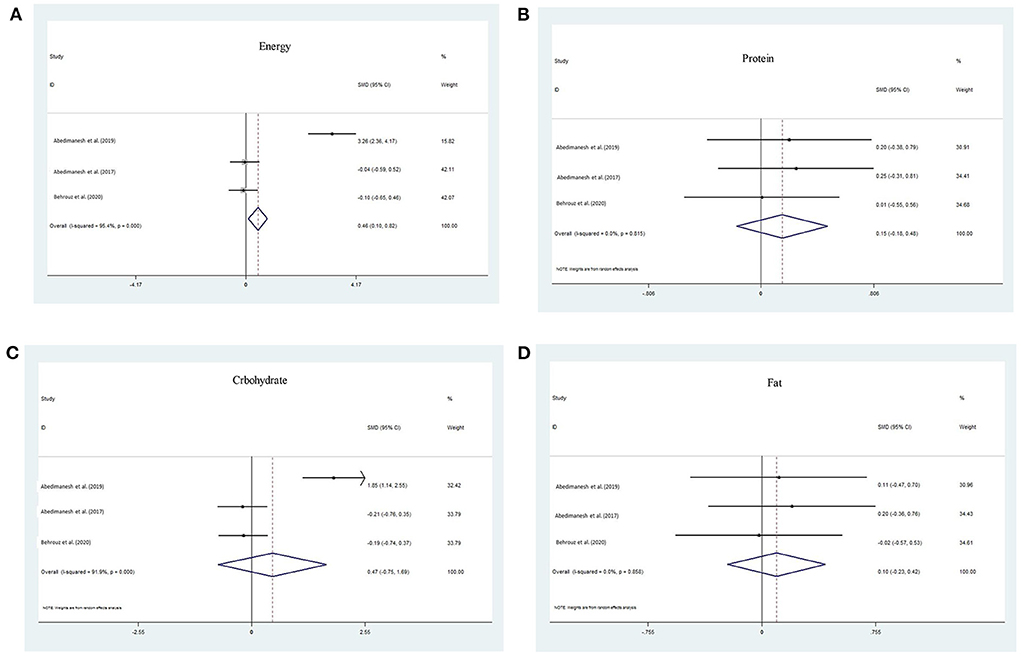
Figure 3. The association between crocin and crocetin and (A) Energy, (B) carbohydrate, (C) protein, and (D) fat.
The association between saffron ingredients on carbohydrate
Random effect meta-analysis of three studies (I2 = 91.9%, Q= 24.69, P = 0.00) showed that carbohydrate were 0.47 fold increase in crocin than control group (pooled SMD: 0.47; 95% CI: −0.75, 1.69) (Figure 3B). Based on the egger test (t = 96.11, p = 0.007).
The association between saffron ingredients on protein
Random effect meta-analysis of three studies (I2 = 0.0%, Q = 0.41, P = 0.815) showed that protein were 0.15 fold increase in crocin than control group (95% CI: −0.18, 0.48) (Figure 3C). Based on the eggertest (t = 0.42, p = 0.748), no publication bias existed.
The association between saffron ingredients on total fat
Random effect meta-analysis of three studies (I2 = 0.0%, Q = 0.31, P = 0.858) showed that fat were 0.01 fold increase in crocin than control group (95% CI: −0.23, 0.42) (Figure 3D). Based on the egger test (t = 0.16, p = 0.9), no publication bias existed (Table 3).
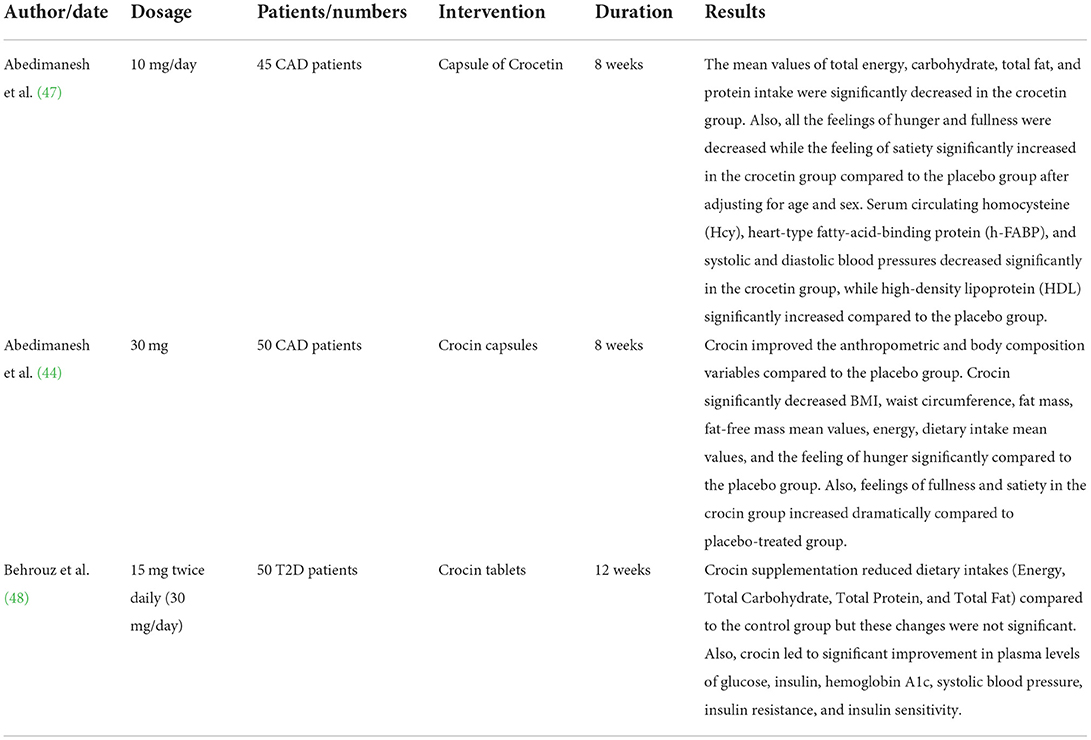
Table 3. Summary of effect estimates of saffron ingredients (crocin and crocetin) for dietary intakes.
Discussion
To the best of our knowledge, the present systematic review and meta-analysis is the first study that evaluated the association between saffron and its ingredients with dietary intakes (energy, carbohydrate, protein, and total fat).
The meta-analysis of data from five clinical trials of saffron showed that the SMD of energy, carbohydrate, and protein was lower in saffron groups than in the control which means that treatment is more effective than a placebo, but for fat, the treatment is less effective than a placebo.
The meta-analysis of data from three clinical trials of crocins showed that the SMD of energy, carbohydrate, protein, and fat was increased in crocin groups than compared to controls, which means that treatment is more efficacious than a placebo, but for fat the treatment is less efficacious than a placebo. The study by Abedimanesh et al. has found that saffron aqueous extract (SAE) and crocin significantly decreased energy and dietary intake mean values in patients with CAD in comparison to a placebo-treated group. In addition, the feeling of hunger decreased significantly in SAE and crocin groups. These changes in the SAE treated group were more efficacious than the crocin group in energy, carbohydrate, and protein intake (44). Some other active components (crocetin and safranal) in addition to crocin may be involved in the effects of the saffron extract on these properties. It may be due to synergistic interactions between bioactive molecules within the saffron composition. The results of the other study also showed that supplementation with saffron powder reduced energy intake, carbohydrate, protein, and total fat in patients with type 2 diabetes (T2D), but these changes were not significant (46). Differences in the duration of the studies and type of diseases may be reasons for these different results.
Saffron ethanolic extract and crocin in a rat model of high-fat, diet-induced obesity restricted appetite and food consumption (49). The results of one study suggested that both saffron and crocin reduced the body weight, food intake, and blood leptin levels significantly compared to the control group and baseline in adult male Wistar rats, and also the effects were comparable to sibutramine (is a serotonin and norepinephrine reuptake inhibitor which has been used for short- and long-term therapy of obesity) (50). These results confirmed the anorexigenic effect of saffron and its active ingredients.
Obesity is a significant risk factor for CVD (51). The relationship between macronutrients and cardiovascular disease and mortality in a Prospective Urban Rural Epidemiology study showed that high carbohydrate intake was associated with a higher risk of total mortality, whereas total fat and individual types of fat were related to lower total mortality (52). It has been reported that a high carbohydrate, low protein diet enhanced cardiovascular disease risk compared to a moderate carbohydrate, moderate protein weight loss diet in obese adults (53). It has been reported that high-carbohydrate or high-fat diets have more deleterious metabolic effects. Large randomized controlled trials have shown that a reduction of fat intake as part of a healthy lifestyle combined with weight reduction reduces the risk of diabetes and cardiovascular disease (54).
It has been reported that active components in saffron, such as crocin solely or synergic with other ingredients (picrocrocin, safranal, etc.) can reduce food intake and blood leptin levels as well as modulate neurotransmitter pathways, especially serotonin reuptake (50) and probably it can target appetite control centers and limit food intake.
The results of the current meta-analysis indicate that saffron and its ingredients, due to reduction in energy and dietary intake mean values, restriction of appetite and food consumption in patients with CAD, could reduce the risk factor for CAD (34).
Many studies have examined the properties between crocin or saffron and CVD. Hatziagapiou and Lambrou indicated the role of C. sativus and/or its active constituents (in particular, crocin) as a cardiovascular-protective agent, and this study shows the beneficial results of saffron consumption against ischemia-reperfusion injury (IRI) hyperlipidemia and diabetes due to up-regulation of antioxidant parameters (superoxide dismutase and catalase activity) and anti-inflammatory mediators (IL-10) as well as reduced pro-inflammatory mediators (TNF-α, IL-1β, and IL-6) and anti-apoptotic markers (55). In addition, SAE and crocin could improve the quality of life and depression in patients with CAD (56, 57). These activities might be a reason for body weight loss as a consequence of saffron supplementation. The results of in-vitro study suggested several possible mechanisms for saffron cardio protective properties. Saffron or its main constituents, might reduce blood lipids via inhibiting pancreatic and gastric lipase activity which is a key enzyme for fat absorption and increasing fecal excretion of fat (58). Saffron and its main constituents (crocins, crocetin, and safranal) can alleviate oxidative stress and inflammatory proses, which are associated with the risk of cardiovascular disease. In addition, given that the main pharmacological activity of saffron is attributed to its main constituents.
The results of the current study suggested that crocins are more effective than saffron in dietary intake (energy, carbohydrate, and protein), but because of the safety, easy use, and low price, use of saffron as a spice and food additive suggests instead of its main components such as crocins.
While saffron is an expensive spice, the variety of its biological properties including, anti-oxidation, anti-inflammation, antidepressant, and hypolipidemic actions suggest that the benefits of using saffron outweigh its high price.
Conclusion
The present evidence suggests that saffron and its active constituents might be beneficial for dietary intake (Energy, Carbohydrate, Protein, and total Fat) and support some aspects underlying cardiovascular protective properties of saffron. It should be noted that this study is the first study investigating the effect of saffron and crocin on dietary intakes among CVD patients, therefore, further studies are needed to confirm these findings.
Data availability statement
The original contributions presented in the study are included in the article, further inquires can be directed to the corresponding author.
Author contributions
MK searched the literature and helped in the preparation of the manuscript. FM searched literature and analyzed the results. MRK was responsible for study design, searching the literature, and prepared and revised the manuscript. All authors contributed to the article and approved the submitted version.
Acknowledgments
We thank the vice-chancellor of research at Esfarayen Faculty of Medical Sciences.
Conflict of interest
The authors declare that the research was conducted in the absence of any commercial or financial relationships that could be construed as a potential conflict of interest.
Publisher's note
All claims expressed in this article are solely those of the authors and do not necessarily represent those of their affiliated organizations, or those of the publisher, the editors and the reviewers. Any product that may be evaluated in this article, or claim that may be made by its manufacturer, is not guaranteed or endorsed by the publisher.
References
1. Tamaddonfard E, Farshid AA, Eghdami K, Samadi F, Erfanparast A. Comparison of the effects of crocin, safranal and diclofenac on local inflammation and inflammatory pain responses induced by carrageenan in rats. Pharmacol Rep. (2013) 65:1272–80. doi: 10.1016/S1734-1140(13)71485-3
2. Abdel-Megeid FY, Abdelkarem HM, El-Fetouh AM. Unhealthy nutritional habits in university students are a risk factor for cardiovascular diseases. Saudi Med J. (2011) 32:621–7.
3. Oldridge NB. Economic burden of physical inactivity: healthcare costs associated with cardiovascular disease. Eur J Cardiovasc Prevent Rehabil. (2008) 15:130–9. doi: 10.1097/HJR.0b013e3282f19d42
4. Ebrahimi M, Kazemi-Bajestani SM, Ghayour-Mobarhan M, Ferns GA. Coronary artery disease and its risk factors status in iran: a review. Iranian Red Crescent Med J. (2011) 13:610–23. doi: 10.5812/kowsar.20741804.2286
5. Montazerifar F, Bolouri A, Mahmoudi Mozaffar M, Karajibani M. The prevalence of metabolic syndrome in coronary artery disease patients. Cardiol Res. (2016) 7:202–8. doi: 10.14740/cr507w
6. Gunstad J, Luyster F, Hughes J, Waechter D, Rosneck J, Josephson R. The effects of obesity on functional work capacity and quality of life in phase II cardiac rehabilitation. Preventive Cardiol. (2007) 10:64–7. doi: 10.1111/j.1520-037X.2007.05860.x
7. Nikolopoulou A, Kadoglou NPE. Obesity and metabolic syndrome as related to cardiovascular disease. Expert Rev Cardiovasc Ther. (2012) 10:933–9. doi: 10.1586/erc.12.74
8. Beaglehole R, Magnus P. The search for new risk factors for coronary heart disease: occupational therapy for epidemiologists? Int J Epidemiol. (2002) 31:1117–22. doi: 10.1093/ije/31.6.1117
9. Tang GY, Meng X, Li Y, Zhao CN, Liu Q, Li HB. Effects of Vegetables on Cardiovascular Diseases and Related Mechanisms. Nutrients. (2017) 9:857. doi: 10.3390/nu9080857
10. Pourmasoumi M, Hadi A, Najafgholizadeh A, Kafeshani M, Sahebkar A. Clinical evidence on the effects of saffron (Crocus sativus L.) on cardiovascular risk factors: a systematic review meta-analysis. Pharmacol Res. (2019) 139:348–59. doi: 10.1016/j.phrs.2018.11.038
12. Boskabady MH, Mokhtari-Zaer A, Khazdair MR, Memarzia A, Gholamnezhad Z.Chapter 17 - Crocus sativus L. (Saffron) and Its Components Relaxant Effect on Smooth Muscles and Clinical Applications of This Effect. In: Sarwat M. and Sumaiya S. (eds.) Saffron. Academic Press, Elsevier(2020).
13. Milajerdi A, Jazayeri S, Hashemzadeh N, Shirzadi E, Derakhshan Z, Djazayeri A, et al. The effect of saffron (Crocus sativus L.) hydroalcoholic extract on metabolic control in type 2 diabetes mellitus: a triple-blinded randomized clinical trial. J Res Med Sci. (2018). 23:16. doi: 10.4103/jrms.JRMS_286_17
14. Dwyer AVW, Dawn L, Hawrelak JA. Herbal Medicines, other than St. John's Wort, in the treatment of depression: a systematic review. Alternat Med Rev. (2011) 16:40–9.
15. Fernández JA. Biology, Biotechnology and Biomedicine of Saffron. Trivandrum Research Signpost. (2004).
16. Bathaie SZ, Mousavi SZ. New applications and mechanisms of action of saffron and its important ingredients. Crit Rev Food Sci Nut. (2010) 50:761–86. doi: 10.1080/10408390902773003
17. Rezaee R, Hosseinzadeh H. Safranal: from an aromatic natural product to a rewarding pharmacological agent. Iran J Basic Med Sci. (2013) 16:12–26.
18. Hosseinzadeh H. Saffron: a herbal medicine of third millennium. Jundishapur J Nat Pharm Prod. (2014) 9:1–2. doi: 10.17795/jjnpp-16700
19. Abdullaev FI. Cancer chemopreventive and tumoricidal properties of saffron (Crocus sativus L.). Exp Biol Med. (2002) 227:20–25. doi: 10.1177/153537020222700104
20. Aung HH, Wang CZ, Ni M, Fishbein A, Mehendale SR, Xie JT, et al. Crocin from Crocus sativus possesses significant anti-proliferation effects on human colorectal cancer cells. Exp Oncol. (2007) 29:175–80.
21. Hosseinzadeh H, Sadeghnia HR, Ziaee T, Danaee A. Protective effect of aqueous saffron extract (Crocus sativus L.) and crocin its active constituent, on renal ischemia-reperfusion-induced oxidative damage in rats. J Pharm Pharm Sci. (2005) 8:387–93.
22. Mohamadpour AH, Ayati Z, Parizadeh MR, Rajbai O, Hosseinzadeh H. Safety evaluation of Crocin (a constituent of saffron) tablets in healthy volunteers. Iran J Basic Med Sci. (2013) 16:39–46.
23. Modaghegh MH, Shahabian M, Esmaeili HA, Rajbai O, Hosseinzadeh H. Safety evaluation of saffron (Crocus sativus) tablets in healthy volunteers. Phytomedicine. (2008) 15:1032–7. doi: 10.1016/j.phymed.2008.06.003
24. Abe K, Saito H. Effects of saffron extract and its constituent crocin on learning behaviour and long-term potentiation. Phytother Res. (2000) 14:149–52.3.0.CO;2-5“ target=”_blank“>https://doi.org/10.1002/(SICI)1099-1573(200005)14:3<149::AID-PTR665>3.0.CO;2-5
25. Soeda S, Ochiai T, Shimeno H, Saito H, Abe K, Tanaka H, et al. Pharmacological activities of crocin in saffron. J Nat Med. (2007) 61:102–11. doi: 10.1007/s11418-006-0120-9
26. Hosseinzadeh H, Noraei NB. Anxiolytic and hypnotic effect of Crocus sativus aqueous extract and its constituents, crocin and safranal, in mice. Phytother Res. (2009) 23:768–74. doi: 10.1002/ptr.2597
27. Kianmehr M, Khazdair MR. Possible therapeutic effects of Crocus sativus stigma and its petal flavonoid, kaempferol, on respiratory disorders. Pharm Biol. (2020) 58:1140–9. doi: 10.1080/13880209.2020.1844762
28. Mousavi SZ, Bathaie SZ. Historical uses of saffron: identifying potential new avenues for modern research. Avicenna J Phytomed. (2011) 1:57–66.
29. Agha-Hosseini M, Kashani L, Aleyaseen A, Ghoreishi A, Rahmanpour H, Zarrinara AR, et al. Crocus sativus L. (saffron) in the treatment of premenstrual syndrome: a double-blind, randomised and placebo-controlled trial. BJOG. (2008) 115:515–9. doi: 10.1111/j.1471-0528.2007.01652.x
30. Nemati H, Boskabady MH, Ahmadzadef Vostakolaei H. Stimulatory effect of Crocus sativus (saffron) on beta2-adrenoceptors of guinea pig tracheal chains. Phytomedicine. (2008) 15:1038–45. doi: 10.1016/j.phymed.2008.07.008
31. Khazdair MR, Boskabady MH, Hosseini M, Rezaee R, Tsatsakis AM. The effects of Crocus sativus (saffron) and its constituents on nervous system: a review. Avicenna J Phytomed. (2015)5:376–91. doi: 10.22038/AJP.2015.4503
32. Rastogi S, Pandey MM, Rawat A. Traditional herbs: a remedy for cardiovascular disorders. Phytomedicine. (2016) 23:1082–9. doi: 10.1016/j.phymed.2015.10.012
33. Mcewen BJ. The influence of herbal medicine on platelet function and coagulation: a narrative review. Semina Thromb Hemost. (2015) 41 300–14. doi: 10.1055/s-0035-1549089
34. Sobhani Z, Reza Nami S, Ahmad Emami S, Sahebkar A, Javadi B. Medicinal plants targeting cardiovascular diseases in view of Avicenna. Curr pharm des. (2017) 23:2428–43. doi: 10.2174/1381612823666170215104101
35. Moher D, Liberati A, Tetzlaff J, Altman DG. Preferred reporting items for systematic reviews and meta-analyses: the PRISMA statement. PLoS Med. (2009) 6:e1000097. doi: 10.1371/journal.pmed.1000097
37. Melsen WG, Bootsma MCJ, Rovers MM, Bonten MJM. The effects of clinical and statistical heterogeneity on the predictive values of results from meta-analyses. Clin Microbiol Infec. (2014) 20:123–9. doi: 10.1111/1469-0691.12494
38. Higgins JP, Thomas J, Chandler J, Cumpston M, Li T, Page MJ, et al. Cochrane Handbook for Systematic Reviews of Interventions. John Wiley & Sons(2019). Available online at: https://training.cochrane.org/handbook/current
39. Higgins JP, Thompson SG, Deeks JJ, Altman DG. Measuring inconsistency in meta-analyses. BMJ. (2003) 327:557–60. doi: 10.1136/bmj.327.7414.557
40. Cohen J. Statistical Power Analysis for the Behavioral Sciences. 2nd ed. New York, NY: Taylor & Francis, Routledge (1988).
41. Faraone SV. Interpreting estimates of treatment effects: implications for managed care. Pharmacol Ther. (2008) 33:700–11.
42. Milajerdi A, Jazayeri S, Bitarafan V, Hashemzadeh N, Shirzadi E, Derakhshan Z, et al. The effect of saffron (Crocus sativus L.) hydro-alcoholic extract on liver and renal functions in type 2 diabetic patients: a double-blinded randomized and placebo control trial. J Nut Intermed Metabol. (2017) 9:6–11. doi: 10.1016/j.jnim.2017.07.002
43. Azimi P, Ghiasvand R, Feizi A, Hosseinzadeh J, Bahreynian M, Hariri M, et al. Effect of cinnamon, cardamom, saffron and ginger consumption on blood pressure and a marker of endothelial function in patients with type 2 diabetes mellitus: a randomized controlled clinical trial. Blood Press. (2016) 25:133–40. doi: 10.3109/08037051.2015.1111020
44. Abedimanesh N, Bathaie SZ, Abedimanesh S, Motlagh B, Separham A, Ostadrahimi A. Saffron and crocin improved appetite, dietary intakes and body composition in patients with coronary artery disease. J Cardiovasc Thorac Res. (2017) 9:200–8. doi: 10.15171/jcvtr.2017.35
45. Milajerdi A, Jazayeri S, Shirzadi E, Hashemzadeh N, Azizgol A, Djazayery A„ et al. xThe effects of alcoholic extract of saffron (Crocus satious L.) on mild to moderate comorbid depression-anxiety, sleep quality, and life satisfaction in type 2 diabetes mellitus: a double-blind, randomized and placebo-controlled clinical trial. Complement. Ther. Med. (2018) 41:196–202. doi: 10.1016/j.ctim.2018.09.023
46. Ebrahimi F, Aryaeian N, Pahlavani N, Abbasi D, Hosseini AF, Fallah S, et al. The effect of saffron (Crocus sativus L.) supplementation on blood pressure, and renal and liver function in patients with type 2 diabetes mellitus: a double-blinded, randomized clinical trial. Avicenna J Phytomed. (2019)9:322–33.
47. Abedimanesh S, Bathaie SZ, Ostadrahimi A, Asghari Jafarabadi M, Taban Sadeghi M. The effect of crocetin supplementation on markers of atherogenic risk in patients with coronary artery disease: a pilot, randomized, double-blind, placebo-controlled clinical trial. Food Func. (2019) 10:7461–75. doi: 10.1039/C9FO01166H
48. Behrouz V, Dastkhosh A, Hedayati M, Sedaghat M, Sharafkhah M, Sohrab G. The effect of crocin supplementation on glycemic control, insulin resistance and active AMPK levels in patients with type 2 diabetes: a pilot study. Diabetol Metab Syndr. (2020) 12:59. doi: 10.1186/s13098-020-00568-6
49. Mashmoul M, Azlan A, Yusof BN, Khaza'ai H, Mohtarrudin N, Boroushaki MT. Effects of saffron extract and crocin on anthropometrical, nutritional and lipid profile parameters of rats fed a high fat diet. J Func Food. (2014) 8:180–7. doi: 10.1016/j.jff.2014.03.017
50. Kianbakht S, Hashem Dabaghian F. Anti-obesity and anorectic effects of saffron and its constituent crocin in obese Wistar rat.  . (2015) 14:25–33.
. (2015) 14:25–33.
51. Hedley AA, Ogden CL, Johnson CL, Carroll MD, Curtin LR, Flegal KM. Prevalence of overweight and obesity among US children, adolescents, and adults, 1999-2002. Jama. (2004) 291:2847–50. doi: 10.1001/jama.291.23.2847
52. Investigators S, Dehghan M, Mente A, Zhang X, Swaminathan S, Li W, et al. Associations of fats and carbohydrate intake with cardiovascular disease and mortality in 18 countries from five continents (PURE): a prospective cohort study. Lancet. (2017) 390:2050–62.
53. Lasker DA, Evans EM, Layman DK. Moderate carbohydrate, moderate protein weight loss diet reduces cardiovascular disease risk compared to high carbohydrate, low protein diet in obese adults: a randomized clinical trial. Nutr Metabol. (2008).5:1–9. doi: 10.1186/1743-7075-5-30
54. Hung T, Sievenpiper JL, Marchie A, Kendall CW, Jenkins DJ. Fat vs. carbohydrate in insulin resistance, obesity, diabetes and cardiovascular disease. Curr Opin Clin Nutr Metab Care. (2003) 6:165–76. doi: 10.1097/00075197-200303000-00005
55. Hatziagapiou K, Lambrou GI. The protective role of Crocus Sativus L. (Saffron) against ischemia- reperfusion injury, hyperlipidemia and atherosclerosis: nature opposing cardiovascular diseases Curr Cardiol Rev. (2018) 14:272–89. doi: 10.2174/1573403X14666180628095918
56. Abedimanesh N, Ostadrahimi A, Bathaie SZ, Abedimanesh S, Motlagh B, Asghari Jafarabadi M, et al. Effects of saffron aqueous extract and its main constituent, crocin, on health-related quality of life, depression, and sexual desire incoronary artery disease patients: a double-blind, placebo-controlled, randomized clinical trial. Iranian Red Crescent Med J. (2017) 19:e13676. doi: 10.5812/ircmj.13676
57. Soheilipur K, Khazdair MR, Moezi SA, Mahmoudirad G. Comparing the effects of saffron, lippia, and saffron-lippia combination on anxiety among candidates for coronary angiography. Avicenna J Phytomed. (2021) 11:515. doi: 10.22038/AJP.2021.18077
Keywords: saffron, crocin, lipid profile, energy, carbohydrate, protein, meta-analysis
Citation: Kianmehr M, Mahdizadeh F and Khazdair MR (2022) The effects of Crocus sativus L. (Saffron) and its ingredients on dietary intakes in cardiovascular disease in Iranian population: A systematic review and meta-analysis. Front. Nutr. 9:890532. doi: 10.3389/fnut.2022.890532
Received: 08 March 2022; Accepted: 06 June 2022;
Published: 04 August 2022.
Edited by:
Antonello Santini, University of Naples Federico II, ItalyReviewed by:
Habib Yaribeygi, Semnan University of Medical Sciences, IranPetros Tarantilis, Agricultural University of Athens, Greece
Copyright © 2022 Kianmehr, Mahdizadeh and Khazdair. This is an open-access article distributed under the terms of the Creative Commons Attribution License (CC BY). The use, distribution or reproduction in other forums is permitted, provided the original author(s) and the copyright owner(s) are credited and that the original publication in this journal is cited, in accordance with accepted academic practice. No use, distribution or reproduction is permitted which does not comply with these terms.
*Correspondence: Mohammad Reza Khazdair, a2hhemRhaXJNUkBCdW1zLmFjLmly; bS5raGF6ZGFpckB5YWhvby5jb20=
†ORCID: Mohammad Reza Khazdair https://orcid.org/0000-0001-9854-6121
 Majid Kianmehr
Majid Kianmehr Fateme Mahdizadeh
Fateme Mahdizadeh Mohammad Reza Khazdair
Mohammad Reza Khazdair